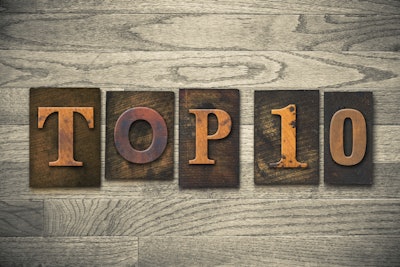
In 2015, visitors to the GreenerPackage.com website demonstrated their desire to learn about the range of options available for pursuing more sustainable packaging. Among the most read articles of the year are several that highlight CPG’s use of alternative materials such as sugarcane, bamboo, and mushrooms to replace petroleum-based plastics, the reuse of recycled materials, and a recycling initiative that puts the focus on flexible film.
10. Bread bag is 36% bio-based: Eureka! Organic Bread switches to bread bags made of 36% sugarcane-based PE in introducing its products to the East Coast market for marketing and sustainability benefits.
9. Gillette razor packs made of renewable-fiber molded tray: Bamboo and bulrush form the basis of new packaging for Procter & Gamble’s Gillette Fusion ProGlide razor.
8. Method is first with 100% RPET detergent bottle: Method overcomes design and manufacturing challenges to create a 53-oz 100% RPET bottle with strong shelf appeal and environmental benefits for its new laundry detergent.
7. Keurig coffee-to-go pods are recyclable: A new hot beverage pod from Keurig, the K-Mug, joins two other pod formats for the Keurig 2.0 brewing system that are now available in recyclable polypropylene.
6. Spring water is packed in more than just a bottle: Spring water company JUST Beverages selects a hybrid package that offers the environmental benefits of a paper carton along with the functionality of a plastic bottle.
5. P&G puts focus on PE film recycling: P&G joins the American Chemistry Council’s Flexible Film Recycling Group to develop and encourage local recycling programs. P&G R&D Manager Stephen Sikra explains why.
4. Brilliant move to mushroom packaging: Lighting manufacturer Rich Brilliant Willing switches to protective packaging made from mushroom ‘roots’ for its wall sconces, enabling faster packing, damage-free shipping, and a more sustainable packaging solution.
3. Biopolymers in packaging—some hurdles, but strong signs of growth: Europe has led the charge when it comes to embracing bio-based packaging. But new and intriguing applications are surfacing in other parts of the world, including Asia and North and South America.
2. Apple purchases 36,000 acres of timberland for packaging: In mid-April, tech giant Apple revealed that it had purchased up to 36,000 acres of American timberland in Maine and North Carolina in an effort to preserve forests while developing a source for eco-friendly packaging for its products.
1. Top five packaging trends for 2015: Reported Ian Lifshitz in early 2015, packaging—irrespective of industry sector—was continuing to undergo an array of important changes that brands and senior-level executives were advised to watch in the coming year.

























